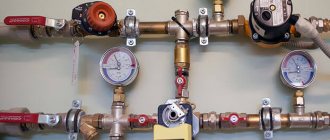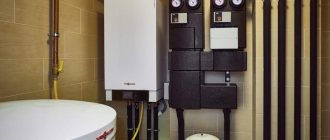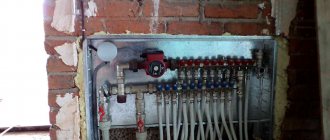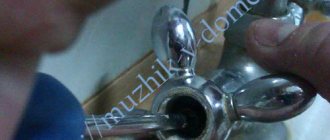Heating is a complex system that has its own design features. Owners often ask the question: why is the radiator hot on top and cold on the bottom? This is a serious problem, it causes a lot of inconvenience and requires careful analysis.
Why is this situation dangerous?
- The actual efficiency of the radiator decreases.
- The room temperature decreases.
- It becomes uncomfortable to be in the room.
- Adjustment and use of additional fittings cannot cope with this situation.
Installed radiator in a wooden house
But what is the reason for such a problem and is there a worthy solution? This issue should be looked into in more detail and some advice given to the owners.
Important!
Please note that a slight temperature difference between the lower and upper parts is not a deviation. You should be concerned when the heating decreases significantly; it negatively affects the efficiency of the radiator.
Why is the bottom of the heating radiator cold? It should be said that in almost all battery models the temperature in the lower part is slightly lower than at the inlet. This is due to the high level of heat transfer; the water has time to cool significantly before leaving the device. A temperature difference arises, which somewhat frightens the owners. So, if there are small differences, there is no need to worry, this is a completely normal situation.
But if the difference increases significantly, the lower part is a little warm or almost cold, then this fact indicates serious problems. The efficiency of the system is significantly reduced, the battery is unable to provide sufficient heat. This negatively affects the temperature in the room, so immediate action must be taken.
The most common reasons:
- During installation, the supply and return pipes were mixed up.
- Low fluid circulation rate.
The first case is quite common; similar situations can arise when connecting independently or using the services of unqualified craftsmen. Any violations of the circuit lead to the impossibility of further full operation of the radiator.
In the second case, the water flow rate inside the radiator is quite low, which negatively affects its operation. The liquid has time to cool completely before leaving the battery. A slowdown in the flow rate can be caused by many reasons, each of which requires prompt elimination.
Incorrect connection
Incorrect pipe connection is one of the possible reasons for reduced radiator efficiency. This is a gross mistake; experienced craftsmen do not make such mistakes; most often they arise after the work is performed by amateurs.
Incorrect radiator installation
The return pipe is connected to the upper pipe, the supply pipe is connected to the lower pipe. As a result, a range of related problems arise:
- The circulation of water and the full operation of the heating system are completely disrupted.
- The efficiency of the radiator and its heat transfer decrease; water is unable to completely fill all sections.
- The process of draining liquid from the battery is disrupted.
Water enters through the lower pipe, passes in a circle and leaves the radiator. Its sections do not warm up, and the actual efficiency is significantly reduced. The upper connection does not allow liquid to be drained from the inside, because the design features of the radiator do not allow the creation of increased pressure to remove it through the upper pipe.
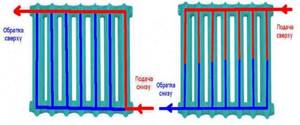
Incorrect and correct connection
Getting inside, hot water tries to immediately rise up, because it has a lower density than cold water. The coolant travels the shortest distance, and the liquid in the sections does not move.
When connected correctly, water enters from above and passes through the upper collector. The radiator has lower pressure, the liquid flows into the columns and is directed to the lower part. This scheme ensures full heating of the battery.
How to fix an incorrect connection:
- Completely disconnect the pipes from the connections.
- Implement a fundamentally different scheme, taking into account that the supply is carried out through the upper pipe, and it should be connected from above, and the return - from below.
- Connect the cells to the battery, open the supply and check the operation of the radiator.
Important!
The first step is always to evaluate whether the battery is properly connected to the system. If it is incorrect, adjustments will need to be made. If there are no errors, you should look for other reasons.
Other reasons
A common reason is a reduced coolant flow rate. This problem can occur in several cases:
- Narrowed pipe section.
- The coolant moves at low speed directly in the heating system.
Low coolant movement speed occurs when the pump power is insufficient to circulate the liquid within the system. Water cannot overcome the radiator with sufficient speed and go into the outlet. A similar problem often arises in gravity systems; they completely lack additional equipment.
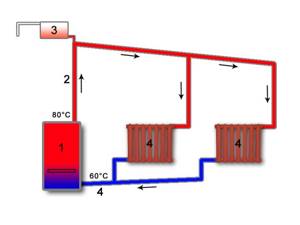
The simplest gravitational scheme
Narrowing of pipes occurs in several cases:
- Incorrect soldering of polypropylene pipes.
- Problems arise when installing an adjustment valve with a narrowed cross-section.
- Presence of deposits in the pipe, reducing throughput.

Another possible reason is a fairly low room temperature. The coolant in the radiator cools faster and delivers the maximum amount of energy. It is quite natural that the bottom of the battery can be much colder.
Important!
It is necessary to conduct a consistent check of the system, evaluate the condition of all elements and find the cause of the problem. In the future, it will be necessary to eliminate it to ensure complete water circulation in the radiator.
Options for organizing the supply and removal of coolant to radiators
When installing heating systems, two main wirings are used: with one or two pipes; a combined supply of free-standing heat exchangers is often practiced. In many cases, the connection points for radiators are their two pipes located on the sides; modifications with two lower outlets are similarly connected when installed using special N-shaped bottom connection units (binoculars).

Fig. 5 Top supply in an apartment building - traffic diagram
Single pipe system
This wiring has become widespread in public utilities and everyday life due to its following advantages and features:
- The option with one pipe is the most profitable from a financial point of view, allowing you to save materials twice as much as compared to a two-pipe one.
- In addition to saving materials, the complexity of installation is reduced and, accordingly, the cost of arranging a single-pipe distribution is reduced - fewer grooves are made in the walls, a relatively small number of different types of fittings are purchased: bends, tees, shut-off and control valves, couplings, the work on assembling the pipeline is accelerated by soldering, press or compression fittings.
- In a line with one pipe, the coolant moves sequentially along the entire chain of radiators, with the first one, closest to the heating boiler or heating network, having the highest heat transfer, and the last one being the coldest.
Elimination
If you notice that the bottom is significantly colder than the top, then urgent action is required. It is necessary to follow the following algorithm to find the cause:
- Checking the correct connection.
- Inspect the radiator, bleed and clean it.
- Assess the condition of the control valves.
- Check the pipes.
- Determine the type of heating system, install or replace the circulation pump.
The first step is to check the correct connection. To do this, it is necessary to estimate the temperature of the lower pipe. If the return and supply were connected incorrectly, it will be hot. You will need to reconnect and build the circuit correctly. When connected correctly, this element remains slightly warm.
How to make radiators hot - looking for solutions
If you find that the return is too cold, you should take a number of steps to find the causes and troubleshoot problems. First of all, you need to check that the connection is correct. If the connection is not made correctly, the down pipe will be hot when it should be slightly warm. The pipes should be connected according to the diagram.
To avoid air pockets that impede the flow of coolant, it is necessary to provide for the installation of a Mayevsky valve or bleeder for air removal. Before bleeding the air, you need to turn off the supply, open the tap and let out the air. Then the tap is turned off and the heating valves open.
Often the cause of cold return is the control valve: the cross-section is narrowed. In this case, the tap must be dismantled and the cross-section increased using a special tool. But it is better to buy a new faucet and replace it.
The reason may be clogged pipes. You need to check them for passability, remove dirt and deposits, and clean them well. If passability cannot be restored, the clogged areas should be replaced with new ones.
If the coolant flow rate is insufficient, you need to check whether there is a circulation pump and whether it meets the power requirements. If it is missing, it is advisable to install it, and if there is a lack of power, replace or upgrade it.
Knowing the reasons why heating may not work efficiently, you can independently identify and eliminate malfunctions. Comfort in the house during the cold season depends on the quality of heating. If you carry out the installation and inspection of the heating system yourself, you can save on hiring third-party labor.
The efficient operation of the heating system determines how comfortable the temperature in the house will be during the cold season. Sometimes situations arise when hot water is supplied to the system, but the batteries remain cold. It is important to find the cause and eliminate it. To solve the problem, you need to know the design of the heating system and the reasons for cold return during hot supply.
Experts explain why the batteries are cold and the riser is hot
You can't warm your hands on cold radiators.
There can be many reasons why the coolant supply pipe is hot and the radiator is cold. For general development, specialists name only the main ones:
- the central valve on the heat supply line is closed or the return line is closed;
- insufficient coolant flow;
- airing of the system or a specific riser, radiator;
- the heating system is not balanced;
- contamination in the heating circuit;
- reducing the cross-section of the coolant supply pipe.
If the riser in the apartment is warm and the radiator is cold, you need to contact the organization responsible for the heat supply of the house. Its specialists are obliged to fix any malfunction free of charge and within 24 hours.
However, the following actions by the residents of the house will help the technicians who come to the call to quickly eliminate the malfunction of the heating circuit:
- Is it necessary to install a hot pipe and a cold radiator in only one apartment or does this problem affect the entire riser. Perhaps the heating wiring of the entire entrance is faulty;
- it doesn’t hurt to go around all the entrances and see if the heating elements are hot there;
- you can go down to the basement and inspect the pipes for breakdowns. Even a dripping leak leads to a fall. This adversely affects her work.

Device for cleaning the circuit.
If the batteries do not heat up the riser
. If the riser is cold, the battery is cold - this is a sure sign that the main line through which the coolant flows is blocked. To confirm this, you need to walk through the neighboring apartments. They should warm up well. In this case, only a plumber, who will have drawings of the heating wiring of the house, can fix the breakdown.
How to make radiators hot - looking for solutions
If you find that the return is too cold, you should take a number of steps to find the causes and troubleshoot problems. First of all, you need to check that the connection is correct. If the connection is not made correctly, the down pipe will be hot when it should be slightly warm. The pipes should be connected according to the diagram.
To avoid air pockets that impede the flow of coolant, it is necessary to provide for the installation of a Mayevsky valve or bleeder for air removal. Before bleeding the air, you need to turn off the supply, open the tap and let out the air. Then the tap is turned off and the heating valves open.
Often the cause of cold return is the control valve: the cross-section is narrowed. In this case, the tap must be dismantled and the cross-section increased using a special tool. But it is better to buy a new faucet and replace it.
The reason may be clogged pipes. You need to check them for passability, remove dirt and deposits, and clean them well. If passability cannot be restored, the clogged areas should be replaced with new ones.
If the coolant flow rate is insufficient, you need to check whether there is a circulation pump and whether it meets the power requirements. If it is missing, it is advisable to install it, and if there is a lack of power, replace or upgrade it.
Knowing the reasons why heating may not work efficiently, you can independently identify and eliminate malfunctions. Comfort in the house during the cold season depends on the quality of heating. If you carry out the installation work yourself, you can save on hiring third-party labor.
Heating is a complex system with its own characteristics. Many people notice that their radiator is cold on the bottom and hot on the top. This problem should definitely be given attention. After all, in this case the radiator does not work at full capacity and, consequently, the temperature in the room drops. But if the temperature difference between the top and bottom of the radiator is small, then there is no need to worry. Let's take a closer look at the possible causes of this problem and ways to eliminate it.
What to do if the radiators in the apartment are cold and the riser is hot?
Regardless of whether the cold heating equipment is only in the riser or in the entire entrance, and possibly throughout the house, you must seek help from qualified specialists. In the case of an apartment building, this is a plumber of the company that is responsible for the heating supply of the house.
Cold batteries with a hot riser may be due to a clogged system or the formation of an air lock in it. An important factor is the pressure in the wiring. In some cases, the problem of low coolant flow is relevant. It is possible to independently find out the reason for the low efficiency of heating elements. But only a true professional in his field will clearly answer any questions that arise and competently fix the breakdown. This video will help you to make your radiators heat better:
Publications on the topic

Garden lunar calendar for December
In winter, when it is cold outside, indoor plants create a special, unique atmosphere of comfort in the apartment. Caring for them according to recommendations.
Similar articles Features of cherries We decided for ourselves that the parents made several mistakes when planting: Before purchasing seedlings.
Answers from forum users and experts to the question: The supply is hot and the return is cold
...what battery do you mean? In a private house or in an apartment? If…
...for hot and cold water and it turns out we pay for cold water per month...
This means there are blockages in the system, everything needs to be cleared.
How many degrees should hot water supply and return be by law?
DHW should be at least 55.60 degrees. If the water is less than 52, bacteria form in the water and the water begins to smell.
In our apartment, we measured the temperature in the batteries with a thermal imager: supply +52, return +28. The temperature in the apartment is +20, and outside -6. If this is the norm, then how to wash in the bathtub if the towel dryer is icy. How can you heat an apartment with such batteries at a temperature of -20 outside? Everything is normal.
why am I cold bro
how to distinguish supply from return in central heating in order to bring it home
bimetallic battery is slightly warm. Embedded in the supply. Bypass and supply pipe are hot. Supply from below
Good evening! Why is it that when heating with a single-circuit AOGV the top is hot and the bottom is cold and one radiator is cold, in two rooms the top and radiators are barely warm, I live in a private wooden house
I have a question why the return supply is 80 degrees 30 degrees of one branch, but the cold return costs two Khoper-100 boilers, reducing 800 square meters of pressure 2 after the pump 3
Residential 5 storey building. The heating from the thermal power plant was turned on. SERVE - cold. The return is warm. They can’t find the reason. Everything is fine in the neighboring house. There are no violations on the route (like the supply and return lines were mixed up). What is the reason? Tell.
private house we can’t start the heating from the gas boiler the hot return doesn’t go any further what to do
private house we can’t start the heating from the gas boiler the hot return doesn’t go any further what to do
private house we can’t start the heating from the gas boiler the hot return doesn’t go any further what to do
After the upstairs neighbors changed the batteries, our return line does not warm up. The supply works fine, but the return after de-airing does not work at all. The neighbors insist that they have nothing to do with it, the emergency lights are of no use, what could be the matter? It's been 1.5 weeks without heating in the living room.
For some reason the batteries do not heat well, it is the return that is cold, tell us what the problem is and how to fix it.
If you have a problem, then I can solve it for you, the batteries do not heat well due to the fact that there is air, the return line is cold, that may be why.
the temperature between the supply and return
is large, I mean there is a difference, then you need to figure it out, it, in principle, should be like that, but not very large.
I advise you to call the housing and communal services department and check everything with a specialist. My supply is boiling and the return is a little warm
Hello, we have a problem with our boiler JUNKERS ZS23AE23/31, the water pressure constantly rises, this happens especially quickly when the heating is on, please tell me what could be the reason, where to look for a breakdown or a link where to read about it. My email [email protected]
Causes of problems with return flow in the batteries of a private or apartment building
There are several reasons why the return flow is not warm enough or even cold. Common problems are:
- insufficient water pressure in the system;
- small section of the pipe through which the coolant passes;
- incorrect installation;
- airiness or contamination of the system.
If a problem with cold return occurs in an apartment, then the first thing you should pay attention to is the pressure. This is especially true for rooms on the upper floors . The fact is that the principle of operation of the return flow is to quickly and continuously circulate liquid through the system. And if its speed drops , then the coolant will not have time to push out cold water and the batteries will not heat up.
Another reason for malfunction of the return flow is contamination of the heating circuit. As a rule, major cleaning of systems in multi-storey buildings is not carried out often . The sediment that accumulates on the pipe walls over time prevents the passage of liquid.
The main reason for interruptions in the operation of the heating system in a private home is incorrect installation . Most often this happens when installation is carried out without the participation of specialists . Being incompetent in this matter, it is quite easy to confuse the supply and return pipes or choose pipes of the wrong size.
Both in an apartment and in a private house, the problem of a heating system malfunction may be associated with insufficient water supply or airiness . In a similar way, the operation of the return line is affected by contamination of the pipes.
Troubleshooting methods. Why is cleaning necessary?
To understand exactly how to solve a problem, you first need to establish its source. If the batteries become cold due to insufficient water circulation, installing a special pump . It will regularly push water into the circuit under a certain pressure, thereby preventing the system from stopping or slowing down.
Photo 2. Marking of the Grundfos circulation pump allows you to choose the most suitable one and install it correctly.
If the reason is that the pipes are clogged, then they just need to be cleaned . You can do this in several ways:
- using a water-pulsating mixture ;
- using biological products ;
- by means of pneumohydraulic hammer .
Important! Such cleaning is carried out regularly in order to prevent the emergence of new problems.
In the event of a malfunction resulting from improper installation of the equipment, contact a technician . A qualified specialist will certainly understand the problem and eliminate all problems. In addition, he will give practical advice and recommendations on the care and operation of the system.
The battery does not heat up
If one or more radiators do not heat or heat poorly, then the first thing you need to do is check if there is air in them using air vents. If water flows from the drains, but the radiator still does not heat, then you need to make sure that both taps of this radiator are open (such inattention can often occur). The next step is to check if the radiator is clogged. To do this, other heating radiators that heat and are on the same branch as the non-working one must be shut off so that all the water flows through this radiator. If it starts to warm up, it means it is not clogged. In this case, it is necessary to hydraulically level the branch. In simple terms, it is necessary to cover the remaining radiators on the branch so that the one who is not working gets more. You need to be prepared that leveling will take more than one day, because the heating system may be slow to respond to changes in settings. If the taps in front of the radiator are completely open, and it is cold, then it is clogged (extremely low probability). Basically, the last radiators on the branch may not heat . But this can always be eliminated by hydraulic leveling. If someone tells you that “it’s not pumping there” or “the pump’s power is insufficient,” don’t rush to believe and touch the pump or pipes. In order to prevent the pump from pumping too much, you need to try very hard when installing the heating system. If one or more of the last radiators does not heat up even after working with the taps, then there may be an air lock in the pipes (see circulation disturbance in the heating system).
The pressure in the heating system drops
Once again, we emphasize that after startup the heating system must operate for several days or even weeks. Air is dissolved in the system; it gradually comes out using automatic air vents and during manual de-airing of radiators. This leads to a loss of pressure. At first, frequent replenishment of the heating system is normal. If the system has been running for more than a month and the pressure drops, then you can check this version. If the volume of the expansion tank is incorrectly calculated, pressure surges in the heating system may occur, as a result of which the safety valve may be activated and water may be released, resulting in a drop in pressure when cooling. If everything is in order with this, then there is a leak in the system, which is not pleasant, you need to look for a leak.
Return is hot and supply is cold
Why is the return hot and the supply cold? This is a rare occurrence. It can be observed when the pump is installed in reverse and without a check valve. This is also possible due to the operation of the heated floor pump. When the floor is first started and heats the structure, it operates at full capacity and can, under certain circumstances, change the circulation in the radiator circuit. Once the floor warms up, it may go away on its own. If the pipes are hidden, then you need to check whether the pipes (supply and return) are mixed up. You can do it in different ways: with water or just blow.
Central heating
How does an elevator unit work?
At the elevator entrance there are valves that cut it off from the heating main. Along their flanges closest to the wall of the house, there is a division of areas of responsibility between homeowners and heat suppliers. The second pair of valves cuts off the elevator from the house.
The supply pipe is always at the top, the return pipe is always at the bottom. The heart of the elevator unit is the mixing unit, in which the nozzle is located. A stream of hotter water from the supply pipe flows into the water from the return pipe, drawing it into a repeated circulation cycle through the heating circuit.
By adjusting the diameter of the hole in the nozzle, you can change the temperature of the mixture entering the heating radiators.
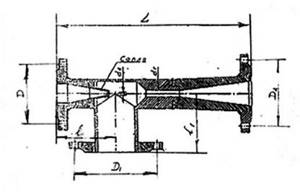
Strictly speaking, an elevator is not a room with pipes, but this unit. In it, supply water is mixed with return water.
What is the difference between the supply and return pipelines of the route?
- In normal operation it is about 2-2.5 atmospheres. Typically, 6-7 kgf/cm2 enters the house on the supply side and 3.5-4.5 on the return side.
Please note: at the exit from the thermal power plant and boiler house the difference is greater. It is reduced both by losses due to the hydraulic resistance of the routes and by consumers, each of which is, simply put, a jumper between both pipes.
- During density tests, pumps pump at least 10 atmospheres into both pipelines. Tests are carried out with cold water with the inlet valves of all elevators connected to the route closed.
No circulation or poor circulation in the heating system
The boiler is working, the pump is definitely working, but there is no circulation in the heating system. Again, the first thing we do is check the air in the radiators. Then, we check the shut-off valves (taps), which may have been closed somewhere due to inattention. The next step is to clean the filter in front of the boiler and in other places, if any. This will solve the issue in 90% of cases, even if the heating system has been recently installed. If not, then we check the heating pipes for the possibility of air pockets in the pipes (see installation of the heating system). If there are such areas in the heating distribution, then the problem can be temporarily solved by draining the water from the radiator under pressure. which is located behind the loop, the flow of water will expel the air from the loop. If possible, an automatic air vent should be installed on large hinges. This will eliminate the problem in the future. If, as a result of the above measures, circulation is not restored, then you need to contact a specialist.
Discuss this article, leave a review on Google+ | VKontakte | Facebook
